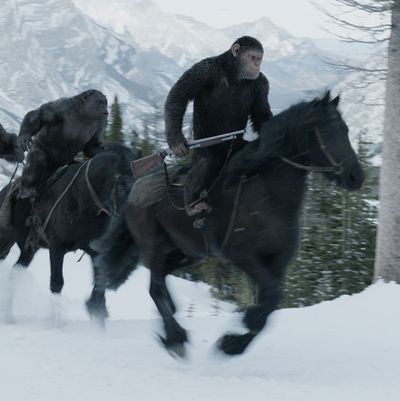
Spoilers for War for the Planet of the Apes below.
It’s gotten to the point where the Planet of the Apes films are so technologically advanced that it’s almost banal to point out how technologically advanced they are. They’re at the bleeding edge of motion-capture technology, inserting Andy Serkis and other actors into the guises of furry primates so fully that they leap to the other side of the uncanny valley. What’s more, the motion-capture suits the ape actors wear are so advanced that the actors don’t need to appear in front of green screens covered in white ping-pong balls — they can be on location and move around mostly unencumbered. Nevertheless, the achievements of the latest film didn’t come easily. Just ask director Matt Reeves. Shortly before Friday’s release of the third installment, War for the Planet of the Apes, we caught up with the filmmaker to talk about three of the hardest scenes to nail in the latest outing.
The Riot
In the movie’s second act, Serkis’s Caesar and his compatriots come across the site where most of the action takes place: an open-air prison for apes, run by militaristic and deeply species-ist humans. At one point, the inmate population erupts into a riot while an ape is being beaten by a human. According to Reeves, this was the hardest scene to pull off because of the limitations of the already-impressive CGI motion-capture tech.
“When you’re doing performance capture, you can only capture about a dozen performances at a time,” he says. “Andy [Serkis] is there, and he’s playing to the key action: the ape who is being beaten. Obviously, the actors who play human characters are there, too. But for the hundreds of apes, you set up a shot and you try to have one person stand in for 20, and you kind of have proxies to set up the shot.” In other words, you shoot as many ape actors in motion-capture getups as the technology allows, but you can only get so many at once.
How do you thread the needle and come up with a finished product? In earlier days of CGI, you might just copy and paste a pack of apes to fill up the environment. Not so here. Instead, you film more apes separately and build out a composite scene. “You have to go through, shot by shot, moment by moment, and fill in each one of those shots until you have the hundreds of apes,” Reeves recalls. “It’s a painstaking process that can take months.”
The War
Speaking of group shots: The film’s finale features the only sequence in War where you see an actual war. For reasons we won’t spoil, the humans start fighting other humans on the land and in the air while the remaining apes make their getaway from the prison complex. First come helicopters, then comes artillery, and finally, a whole army of soldiers in snowsuits storms onto the base just before an avalanche crushes most of them. It’s quite the series of events, and Reeves tackled it in an unusual way.
“I tried to keep this movie in Caesar’s point of view as much as possible,” he says. “So, except for those moments where you were supposed to get the kind of grand indifference of the kind of God’s-eye shot, I wanted you to experience things through Caesar’s point of view. You see them through this crack in the rocks and you’re getting it from his perspective and I tried to be really as rigorous as possible about the point of view.” That meant most of the battle had to be choreographed without the ease of just showing wide-open overhead shots of open spaces — it was seen from the odd angles and hidden positions of a frightened observer.
But don’t worry: No humans were harmed in the making of that avalanche. “We looked at a lot of reference stuff, and actually, when we were up in Calgary, we had the option to do a controlled avalanche,” Reeves says. “But we decided that it would be better because of the scale of what we were doing, to do it full CG and so some of those shots, [special-effects house] Weta created them, whole-cloth, through shots that I laid out with them, and then they realized them in a way that is just astonishing.”
The Encounter
Of all the tough scenes to pull off, Reeves seems most pleased with one that isn’t a spectacle at all: It’s a brief and tender scene wherein the orangutan Maurice (Karin Konoval) comes across a young girl who can’t speak (Amiah Miller). Maurice, too, can’t really speak out loud — the apes largely use sign language, except for the very verbal Caesar — so they communicate their surprising trust and nascent affection wordlessly. There’s no way to distract the viewer with action or dialogue. They have to just stare at this ape and this girl meeting one another and believe in the emotion of what’s happening.
“I thought that that was quintessentially something from an Apes movie,” Reeves says. “I wanted the audience to be Amiah at that moment and have this surreal experience of being stared at by this intelligent and empathetic orangutan. I had Karin just walk right up to the 65-mm camera and look right into the lens. The way Maurice looked — that, to me, is one of the high points, effects-wise, for the movie. I mean, I challenge you to look at that shot where that orangutan is looking at you right into the lens and not believe that that is an orangutan. All of the hairs on Maurice’s face, the detail in the reaction, it’s a very special, uncanny moment.”

